By Jeffrey A. Rendall, Photos by Jeffrey A. Rendall
WILLIAMSBURG, VA – Fifty years is a long time for a golf course, but just a drop in the bucket when talking about history.
2013 marks the 50th anniversary of the opening of the Golden Horseshoe Gold Course, the Robert Trent Jones designed masterpiece set just a stone’s throw from the Colonial Williamsburg historic area.
(Click here for the complete story of the Gold Course.)
This means championship-level golf has been a part of the Colonial Williamsburg Foundation’s portfolio for a comparatively long stretch, but the town was here centuries before.
RTJ’s son, Rees Jones, is also part of the Colonial Williamsburg experience, having designed the Green Course in the early nineties and then later returning to renovate his father’s Gold Course.
Rees was just carrying on the family tradition, but found his work in Virginia’s colonial capitol rewarding as well. “One of the great things about Colonial Williamsburg is that it’s a not-for-profit, so everybody that goes there helps sustain the history of America. So when you spend time there, it’s beneficial – it isn’t just like somebody making money off of your visit.”
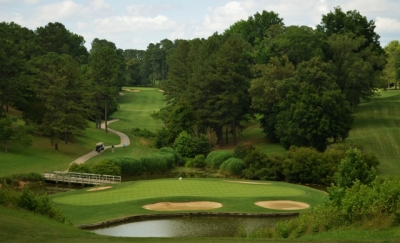 |
| The famous Golden Horseshoe Gold Course celebrates its 50th anniversary this year. |
He continues, “It’s like when you go to Pinehurst, you learn more about the history of the game. I know Bandon Dunes is great, but I think Pinehurst is more steeped in tradition. So I think Colonial Williamsburg, from an American history standpoint, is much like Pinehurst is as a golf resort.”
For us at GolfTheUnitedStates.com, we’ve been enjoying the Golden Horseshoe for well over a decade, but I first visited the restored colonial town in 1985. Some might say that nothing ever changes in Williamsburg, but that’s far from the truth.
The good folks at the Colonial Williamsburg Foundation are continually updating their interpretive programs, so there’s something different every time you visit. If you’re seeking a real opportunity to see “where it all happened,” then Williamsburg is the place.
Colonial Williamsburg presents the story of the colonists’ struggles during the American Revolution – but also offers a realistic view of slavery in the 18th century.
It’s a great place to see how they really lived back then, but also a chance to hash out the issues – both human and political – that continue to challenge Americans today. Talking about the Constitution with James Madison is a unique way to learn, but it’s more than that – it’s an opportunity to see how our country’s distinctive cultural traditions shape our lives.
To that end, we recently caught up with Jim Bradley, the Communications Manager for Colonial Williamsburg, and Bradley was happy to elaborate on how Williamsburg is still shattering pre-conceived notions, even into the 21st century:
GolfTheUnitedStates.com: Having spent a considerable amount of time in Colonial Williamsburg over the past few years, we’re struck by the quality of the presentation and the message that Williamsburg offers its guests. How do you decide on what is depicted and which Colonial characters are selected to express that message?
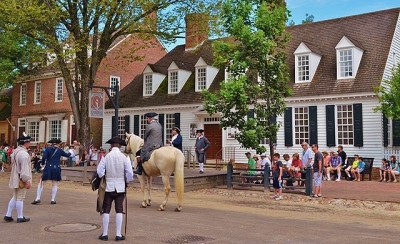 |
| Many of the Revolutionary City dramatizations take place in front of the historic Raleigh Tavern. |
Jim Bradley: Number one, we’re concentrating on a particular time period, and that’s from early 1775 to late 1781. In other words, we’re basically examining the period of the American Revolution -- and, telling Williamsburg’s story and place in that time period.
The people portrayed are, in some cases, those who have some relationship to Williamsburg and figured greatly in the Revolution. Either they lived here or they came here as a legislator or they had some fairly active and prominent role.
But famous people are only part of the narrative. Because, for instance, slightly more than half of the population at the time was of African descent – we want to portray their stories, too.
When I came here to work a couple decades ago, one of the things I remember being said was that America was essentially built by English artisans and African labor. The reasons for that happening are numerous, most of which are economic.
The largest source of income -- in fact the foundation on which the entire colony was based, especially in the colonial period – was from tobacco, which is a very labor-intensive crop and requires effort, not just during the growing season, but all year round.
Slavery essentially comes about because there’s no other way to acquire the number of workers that the colonists needed to grow and process tobacco.
We also portray persons of Williamsburg that nobody’s ever heard of simply because they were not those prominent people like Jefferson and Washington and Patrick Henry and those sorts of folks.
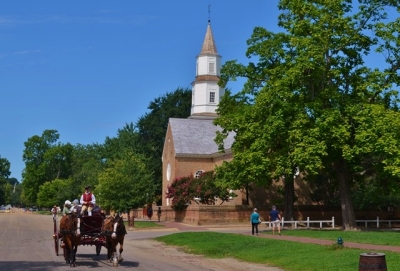 |
| Bruton Parish Church was the place of worship for many Founding Fathers before the Declaration of Independence. |
What we’re trying to do is tell very human stories about the people who lived here and had decisions to make: are you going to be a loyalist, are you going to be a patriot, or are you just going to figure out which way the wind is blowing today?
And then of course, to the enslaved, there’s the inherent conflict presented by the Declaration of Independence, that “all men are created equal” – except for us – and we’re trying to tell that story too. In essence, America’s about to declare independence and we’re going to say everybody’s equal… except you women and you African folks. Just us white men are going to be equal.
Those are sort of the underlying ideas about what we’re trying to get across -- and how those lessons and the issues of that time, and the things that people had to decide for themselves (what’s going to become of me) – how that applies to citizens today.
GolfTheUnitedStates.com: So it’s more than a history lesson.
Jim Bradley: Right.
This “experiment in self-government,” and that’s what it is, has now gone on for 238 years. If that experiment is to continue and eventually succeed, it’s going to require the citizens of today and tomorrow to be just as active, involved and engaged as those citizens of the Revolution were in their times.
That, essentially, is the big underlying message that we’re trying to get across.
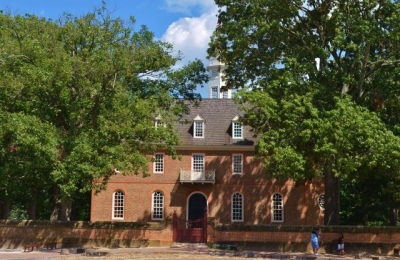 |
| The Virginia Colonial Capitol building was rebuilt during the restoration of Williamsburg, but it is a very close approximation of the real thing. |
We accomplish that by telling stories about these individuals or groups of individuals that came together and made decisions about what they’re going to do – and some of them even decided they were going to be loyalists and they left (went to Canada, the Bahamas or back to England)…
GolfTheUnitedStates.com: How much does “entertainment” factor into your mission? After all, the ‘Revolutionary City’ programs are basically a series of plays or theatrical presentations.
Jim Bradley: One of the ways to capture the audience is to make these messages that you’re trying to get across, in some manner, entertaining.
But we’re still focused on educating at the same time. I’ve heard the phrase edu-tainment, and I think it works well.
We’re trying to mix those elements together into a cohesive story that is also based in fact. We don’t make this stuff up. It’s interesting enough to tell the story the way it really happened -- we don’t have to do a Disney Pocahontas-type revision of history to make it compelling.
GolfTheUnitedStates.com: True. The story is fascinating – and convincing. Is there a difficulty to overcome there, in terms of separating historic reality from peoples’ expectations?
Jim Bradley: That can be – I won’t say a barrier – it can be a hurdle that we need to get over.
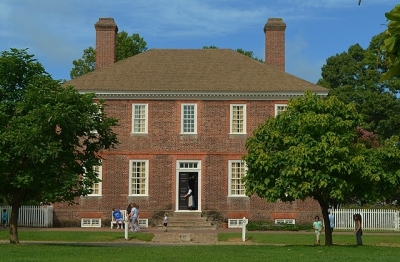 |
| George Wythe signed the Declaration of Independence and tutored Thomas Jefferson and John Marshall in their youth. Here is his house. |
People come here with their own self notions about what happened back then. In many cases, those notions are just totally unfounded. For instance, take the example of slavery. I was just as guilty as anybody else before I started working here.
I came here thinking slavery was entirely an agricultural or agrarian institution and that all slaves were used for was field-hand work. When I came here, I found out that was far from reality -- some slaves were skilled tradesmen, because they were more valuable that way.
A general field-hand might be taxed at a value of say 30, 40 or 50 pounds sterling, where a skilled blacksmith slave could be valued at 3,4, 5 times that much.
They were more valuable simply because they had more skills and they were skills that were in demand. Essentially, urban slavery is very different than this pre-conceived notion that I had about what amounts to plantation slavery.
GolfTheUnitedStates.com: It seems like many people get their sense of history more from legend and folktales than reality.
Jim Bradley: And I think that’s largely due to popular media.
For me, my pre-conceived notions were based pretty much on movies that I’d seen as a kid and later on. And nobody ever mentioned in a history textbook that there was such a thing as skilled, urban slavery.
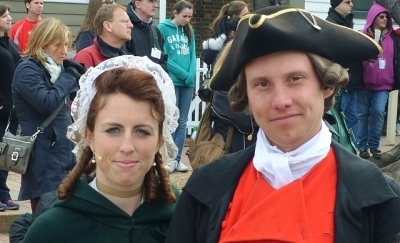 |
| Edmund Randolph and Betsy Nicholas offer a love story fit for the American Revolution. |
Because of that popular media, you get these pre-conceived notions that either don’t apply at all, or they don’t apply universally -- or they leave a large part of the story out.
So yes, I think we have to challenge people to think critically about what we have here, and to be open to something that might rock their world a little bit. And much of the program is designed to provoke that kind of thought.
GolfTheUnitedStates.com: One of the Colonial Williamsburg programs that certainly challenged our pre-conceived notions was the ‘Public Audience’ chats with historic figures such as Patrick Henry and George Washington. The question and answer sessions (after their opening speeches) were particularly captivating.
Jim Bradley: Yes, because the questions people tend to ask are framed from a modern perspective.
For instance, I remember one time when I was at a Thomas Jefferson audience, one of the people in attendance asked him, “Mr. Jefferson, what would you do about terrorists?”
This was shortly after 9/11, within a few months or so – and the United States was preparing to go hunt for Osama Bin Laden.
Jefferson was initially puzzled by the term “terrorists,” because it’s not a word that he would use. But then he replied, “What sort of persons are these terrorists?”
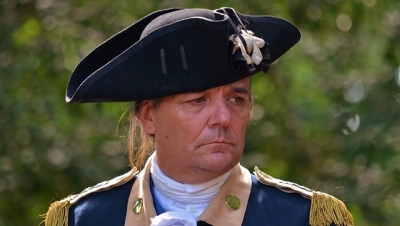 |
| General George Washington is direct and to-the-point as he takes questions during his Public Audience. |
After receiving a general definition, he reminded the audience that as president, he ordered the Marines into Tripoli to deal with the Barbary pirates. Well, those were terrorists of the late 18th century, right? So, in that respect, Jefferson was able to relate his own experience to this fairly modern issue.
All of the historic figures do that, but Patrick Henry sometimes refers to his “remarkable ability to see the future.” He’s the only one that does it that way.
GolfTheUnitedStates.com: Henry did that for us, too, claiming that his views on immigration would avoid any potential divisive conflicts “in the future.” That’s where I think the entertainment and education aspects collide and it’s so well done at Colonial Williamsburg.
Another character we enjoyed quite a lot was James Innes, who shows up in many of the interpretive programs, yet isn’t really found in the history books. How would you choose a character like James Innes to play such a prominent role in the stories in Williamsburg?
Jim Bradley: We’re always looking for those people that nobody knows about but who had a fairly substantial role in history.
As it was, Captain James Innes was actually a student at the College of William & Mary and he served in the local militia. In fact, when Royal Governor Dunmore eventually flees the palace in the middle of the night, Captain Ennis is in charge of the militia unit that comes to seize all the arms and munitions that the governor had decorating the halls of the palace, and takes them back to the magazine -- to their proper storage place.
Innes also figures in a muster on Palace Green the morning after the governor removed the gunpowder from the magazine in April of 1775 (the exact date is April 20, 1775).
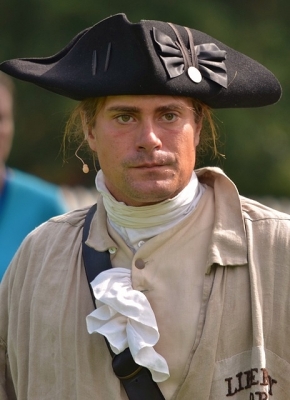 |
| Captain James Innes may not be well represented in the history books, but he played a vital role in stirring up passions before the war. |
Innes is the guy in charge of the militia unit that’s coming up the Green to demand that the governor return the gunpowder. So yes, Captain Innes is somebody who nobody really knows about, unless you’ve seen some of those scenes in our programs. But yet he figures prominently, at least in a few instances, in the history we’re trying to tell.
There’s a reason for each one of the characters to be there in those historic interpretations.
In fact, getting back to the muster on the Palace Green, James Innes and Peyton Randolph almost come to blows during the incident. Randolph is saying, “Look, you hot head, calm down. We’re going to pursue this as peaceably as we can, because if you do what you’re planning to do, this town will overflow with the British Army. It will probably be torched to the ground, and your hot head action could possibly be our own undoing.”
Yes, there’s a drama there, but it tells the real story that the British government was not acting in our best interests as subjects of the King – and that maybe this incident is the turning point. Frankly, almost the same day that the action on Palace Green occurs is when the Redcoats marched on Lexington and Concord up in Massachusetts.
So the two events almost coincide.
GolfTheUnitedStates.com: So there’s another connection to a story that people may be more familiar with, the “Shot heard ‘round the world” up near Boston?
Jim Bradley: Exactly.
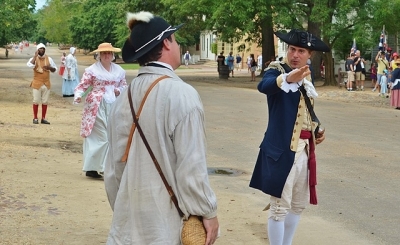 |
| James Innes explains strategy to a militiaman during a scene in the Revolutionary City program. |
It turns out that the foreign ministry of Parliament had sent letters to each one of the Royal Governors in all 13 Colonies, telling them to ‘take the arms away from the colonists.’ The easiest way to disarm the citizens was to remove the gunpowder – a musket is useless without it.
And here’s the excuse you (the Governors) can use: we’ve heard rumors of huge slave revolts -- and we don’t want these arms to fall into the slaves’ hands.
The notorious British army up in Massachusetts was acting on the same orders that Governor Dunmore was in Virginia, by removing the gunpowder. And I don’t think people realize how almost simultaneous those two events happened to be.
It may occur to them, especially if they know that April 19th is the day it happens in Massachusetts – and that the morning of the 20th of April, the day after – is the night that Governor Dunmore has the Marines remove the gunpowder in Williamsburg.
(Ed note: Paul Revere’s famous “The Redcoats are coming!” ride took place on the night of April 18th)
It’s as simultaneous as you can get in a period where communications between those two places – Massachusetts and Virginia – could take three or four weeks to reach their destination.
And then later in some of the re-enactments that we do, the news does arrive from Massachusetts that the Minutemen have been attacked. Six were killed and four were wounded.
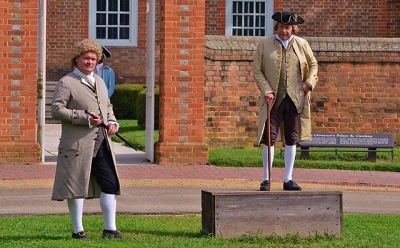 |
| Royal Governor Dunmore addresses an angry mob of colonists during the Gunpowder incident. |
I think these dramatic re-enactments may help people relate that these key historic events are happening very close to each other… that maybe the die is cast and there’s no turning back. You wonder.
GolfTheUnitedStates.com: It’s great that your programs are helping to convey that message.
It’s also interesting to see how Colonial Williamsburg has evolved over the years. I went there for the first time in 1985, when it was much more of a museum-type of interpretation.
How has it changed?
Jim Bradley: It was sort of a collection of house museums back then.
Actually, we began what we called “character interpretation” in the late 70’s. 1979 I think was the date. That was also about the time we embarked on acknowledging that there were African-Americans here and trying to do our best not only to portray their presence and contributions to American history, but the issues and problems that they faced as well.
The 70’s was a turning point for Colonial Williamsburg in the sense that we sort of got out of the house museum business and tried to make our interpretations somewhat more interactive. And I think our current ‘Revolutionary City’ programming does that very well.
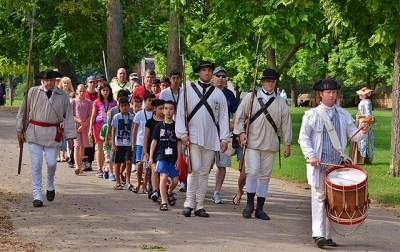 |
| Be prepared to participate if you come to Colonial Williamsburg. It will provide memories - and it is fun, too. |
I’ve been here almost 25 years and observing the changes in interpretive programs over those years is almost like watching grass grow. It has been a long process, but when I compare what’s here now to what I saw 25 years ago – or especially in 1955, when I first visited Colonial Williamsburg as a 10 year-old -- it doesn’t look like the same place anymore.
That’s because it’s not the same place it was even ten years ago. The Revolutionary City program has now been in place for eight years and I’ve seen tremendous growth in it just in that period of time – from its inception and beginning to today.
GolfTheUnitedStates.com: Since some readers may not be familiar with the Revolutionary City program, what are you trying to accomplish with it?
Jim Bradley: Again, we’re trying to tell the story of Colonial Williamsburg from 1775 to 1781 through timeline theatrical presentations and re-enactments.
This year, we started doing this whole time period in a single day sequence of these programs, whereas up until this year, the timing was spread over two days. The first day was from the beginning up to the Declaration of Independence, and then, the second day was essentially the war years from Declaration to Yorktown.
However, our audience research indicated that people were having some difficulty in fitting those two days of stories together into a continuous narrative. So this year, we started putting them together as a one-day event, starting in the morning and going right up to 5 o’clock in telling that complete tale in one day.
The sequence of events does make more sense now. If there’s a disadvantage to the new format, it’s that if you see each one of these programs -- from the first one in the morning until the last one in the afternoon -- it doesn’t leave you a whole lot of time to do much else.
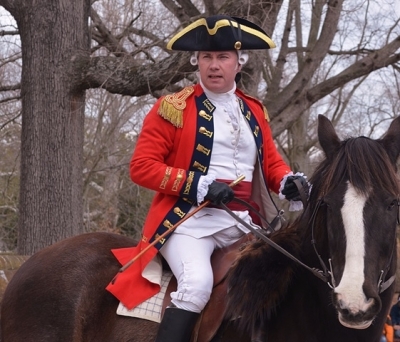 |
| Notorious American traitor Benedict Arnold tries to sway the colonists in Williamsburg, but receives a cold reception. |
But it might actually benefit us in the long run, too – people will want to stay more than one day.
GolfTheUnitedStates.com: There’s no way the Williamsburg experience can be grasped in one day.
The final question I would ask you – how much license do the characters have in terms of historic fact? How much interpretation do they have in regards to expressing what the actual person really believed?
Take for example James Madison -- we had a conversation with him about the Constitution that was not yet written, and he did an exceptional job in talking about things like natural rights under philosophers such as John Locke and Montesquieu.
These folks must spend a tremendous amount of time researching the characters.
Jim Bradley: They do. But the amazing thing about Madison in particular – Brian Austin, who portrays James Madison, only started working here in February.
James is brand new, essentially, but it amazes me how much he has absorbed in such little time. Besides doing his own research, he also has our house historian to rely on. So the actors really do have access to quite a lot of information on the people who they portray.
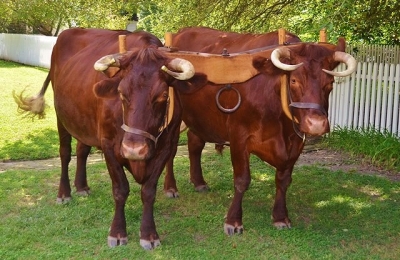 |
| Colonial Williamsburg brings the animals up close. |
But there’s more: the characters can also use anecdotes from the people that the real person knew, or associated with – and what their thoughts and opinions were.
It requires the actors to become a more well-rounded representation of the person that they’re portraying. And essentially, their own research makes them much more believable, because they can talk about “their friend from Gloucester,” etc… and why they’re a friend or business associate, whatever their relationship is.
That helps them become much more believable as a character.
But they can’t just make stuff up.
GolfTheUnitedStates.com: Speaking of believability, there was one loaded question from a gentleman who asked a gathering of colonial characters if they could imagine a black man leading a great nation someday. How would they be able to take the character’s actual views and answer something like that?
Jim Bradley: They would certainly have to have some background about the contemporary attitudes of the time.
I could imagine what the characters’ answer was – that no, they couldn’t imagine that ever happening.
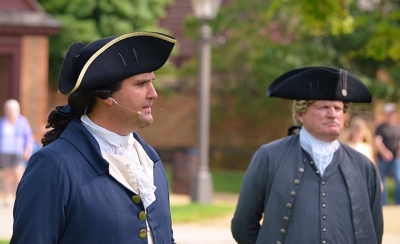 |
| Peyton Randolph was president of the First Continental Congress and a prominent Virginian before the American Revolution. |
But their answers would reflect what the attitude of the time was, and it’s a truthful answer. It may not be what the person asking the question wants to hear, but it still reflects the attitude of the time.
GolfTheUnitedStates.com: Do you ever get any complaints from visitors on the interpretations of the characters?
Jim Bradley: I suppose we get complaints from both sides of the aisle, if you will. We’re either too liberal or too conservative or whatever.
Sometimes we do get complaints about, for instance, African-American portrayals, simply because, as I said, we’re all products of our own attitudes. And in many cases those complaints are really not very well founded at all, if not completely unfounded.
It’s just that the person making the complaint happens to disagree with what we’re doing.
My answer to those folks is, “Okay, you want to live in colonial revival? Go back to the 1920’s. And there you can believe that colonial life was just a bed of roses.”
For example, portions of the HBO miniseries ‘John Adams’ was shot here. What I was very struck with was, there was no effort to make life back then look “pretty.”
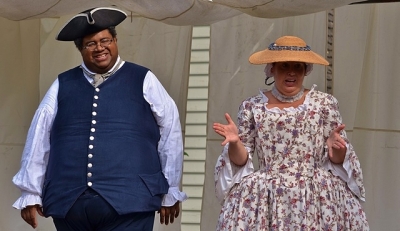 |
| In addition to real history, Colonial Williamsburg offers many chances to see authentic 18th Century entertainment as well. |
Okay, Williamsburg is a really clean place now compared to what it was in the 18th century. We know that because we find trash pits from that time period. We know that there was no garbage pick-up, so you just tossed it out in the yard or out in the street or wherever you wanted to toss it. I imagine the place smelled.
But we’re not going to re-create that…
______________________________________________________________________________
In that sense, Colonial Williamsburg is not an exact replica of the town from over two centuries ago, but it’s a wonderful place to bring your family, stimulate your mind a little bit, and learn about our nation’s heritage – both the aspects we’re proud of, and some facets we’d rather forget.
The Williamsburg area in general is perhaps given too little credit as an all-around destination. “There’s just really no other place that has so much to offer for everybody in your family,” Rees Jones said. “The historical aspect, then Busch Gardens, the town itself has phenomenal shopping, and then you’ve got William & Mary College and the activities there.”
Not to mention a plethora of dining choices, from world-class cuisine down to your standard fast-food offerings.
Thanks to men like Rees Jones and his father, golfers have had the chance to enjoy the Golden Horseshoe for 50 years now – and thanks to the efforts of the Colonial Williamsburg Foundation, everyone can continue to come to Williamsburg for the best in golf, leisure and family vacations, well into the future.
With a little history lesson included, just for the taking.
Details:
The Colonial Williamsburg Foundation
P.O. Box 1776
Williamsburg, VA 23187
Telephone: (888) 965-7254
Website: www.ColonialWilliamsburg.com
For more information on the Golden Horseshoe Golf Club:
Click here for the complete story of the Gold Course.
Click here for a complete review of Rees Jones’ Green Course.
| Related Links | Comments on this article? | |
|
Maryland National Golf Club Hollow Creek Golf Club Rocky Gap Resort PB Dye Golf Club in Ijamsville Whiskey Creek Golf Club |
E-mail Jeff Rendall, Editor: jrendall@golftheunitedstates.com |












